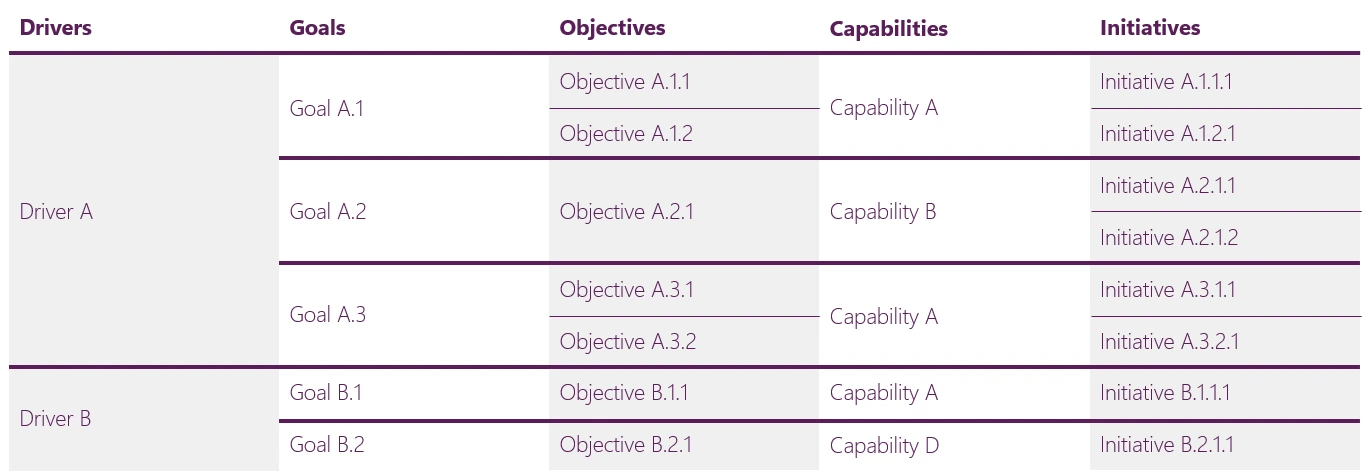By leveraging Business Architecture, it is possible to create a Table from strategy to execution. This table embodies the entire strategy of the organization, including its drivers, goals, objectives, capabilities, and initiatives.
Leveraging Business Architecture
The method cited here is a derivative of the approach that comes from the Business Architecture perspective. The approach is described in detail in the BIZBOK Guide [1]. With this in mind, the process of getting from the defined strategy to its implementation is carried out using five process steps.

- Determine strategy. Strategy development consists of identifying drivers, goals, and intended (and measurable) objectives. Of course, the Enterprise Architecture plays an important role in understanding the impact of the chosen strategy on the organization. This section addresses (part of) the second stage of the Enterprise Architecture Implementation Wheel, Define.
- Designate change. The process step of designing the required changes is characterized by identifying the changes needed to implement the strategy. Therefore, this step requires intensive collaboration with key stakeholders. Enterprise architecture is used in this step to further interpret and decompose the changes. It is also used to plan initiatives across the organization. Stage one of the Implementation Wheel, Document, plays an important role here.
- Determine roadmap. An architecture roadmap uses the captured initiatives. In this step, the Enterprise Architecture is used to shape the required initiatives so that they can be used in a roadmap. Creating a roadmap with the required initiatives deals with the third stage in the Implementation Wheel, namely Execute.
- Develop solutions. The fourth step in the strategy to execution process is the development of solutions. However, Enterprise Architecture is not (directly) involved in designing solutions. That role is reserved for Solution Architecture. What is important in this step is to provide frameworks so that a solution can be arrived at.
- Measure progress. Finally, measurable indicators are used to monitor the progress of strategy implementation. The fourth stage of the Implementation Wheel, Control, explores this topic in more detail.
Important note
It is important to note in the figure above that the order of the steps shown is different from the order described in the Implementation Wheel. The first two steps from the figure are shown in reverse order on the Implementation Wheel. This is where theory and practice diverge. Theory (e.g., the TOGAF Standard and the BIZBOK Guide) indicates that you should start by formulating goals and outcomes. This allows the strategy to move towards implementation. The theory is correct, but practice shows otherwise. In practice, translating the strategic agenda into concrete goals and objectives is not the first thing an Enterprise Architect will do.
Creating the table
To create a Table from strategy to execution, the following steps can be taken.
- Start by recording the strategic drivers in the table.
- Then complete the goals and associated objectives. So work with senior management and subject matter experts to formulate KPIs for the goals and identify corresponding metric thresholds. These metrics will be useful in stage four, Control.
- Use the SMART method to make goals and objectives measurable.
- Determine what capabilities are needed to implement the initiatives. The identified capabilities can later be used to identify the affected elements from the various architectural domains. For example, consider business processes, business actors, information concepts, applications, and technology.
- List the initiatives to achieve the objectives and those affected by each objective.

Graphical representation
At first glance, visualizing an existing organization’s strategic agenda in this way may seem like a daunting task. In practice, it’s not so bad. What makes it easier is having clear definitions and descriptions of all the elements mentioned (drivers, goals, objectives, and initiatives). Without clear descriptions of these elements, creating and filling in a table like the one in the example becomes much more difficult.

More information
For additional information about creating a Table from strategy to execution, please refer to Chapter 8, Section 8.4.1, of my book Getting Started with Enterprise Architecture.
Back to
[1] Business Architecture Guild®, A Guide to the Business Architecture Body of Knowledge®, vol. 11.0. 2022.
